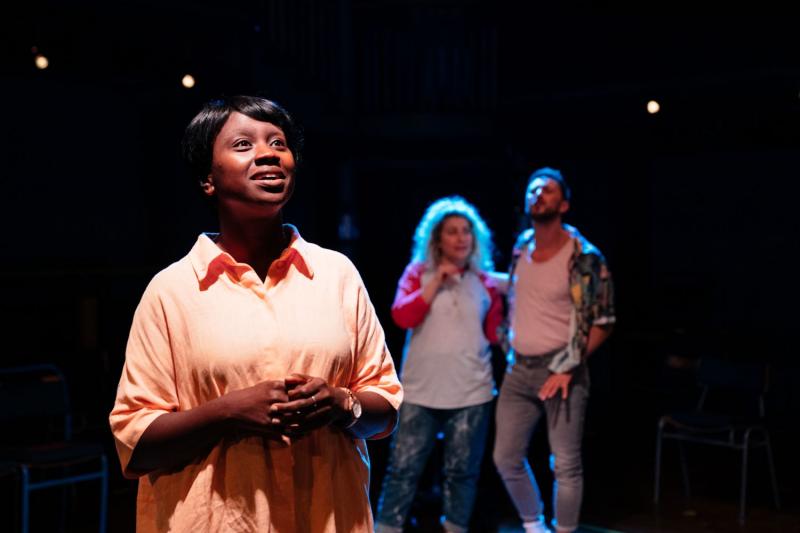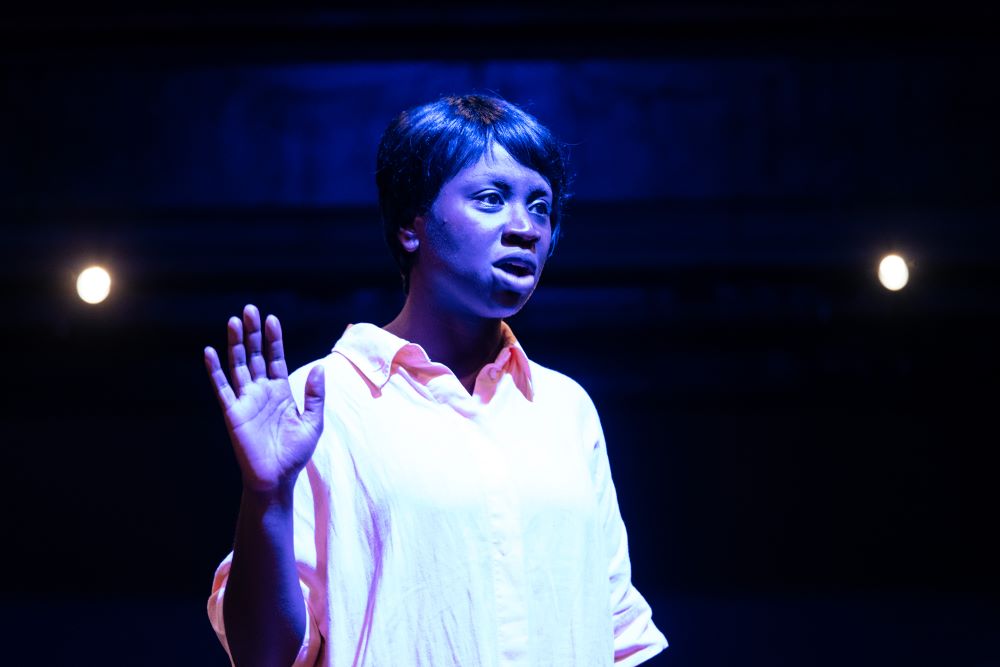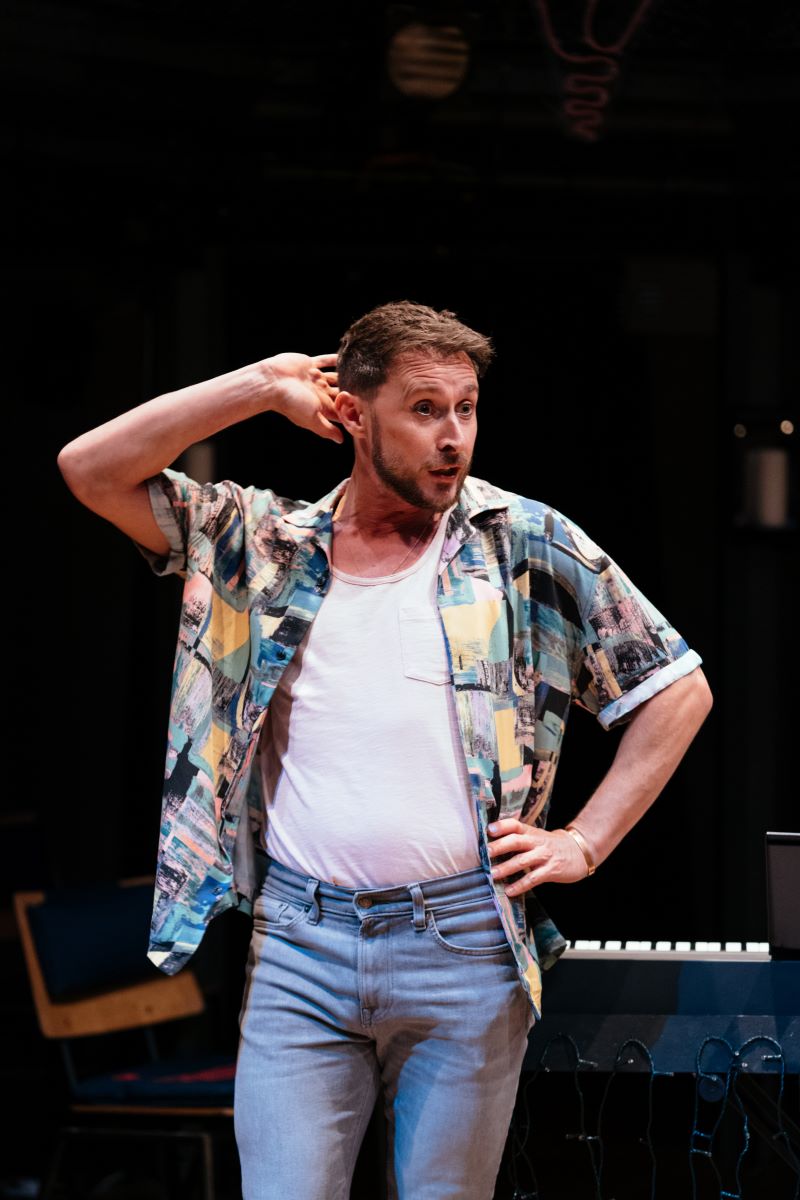Last Easter, Orange Tree Theatre review - over-performative and strangely off-putting | reviews, news & interviews
Last Easter, Orange Tree Theatre review - over-performative and strangely off-putting
Last Easter, Orange Tree Theatre review - over-performative and strangely off-putting
The lighting's gorgeous, but Bryony Lavery's drama about theatre friendships never quite clicks

Last Easter has become a lot more relatable since it was forced to postpone this run at the Orange Tree Theatre, originally scheduled for 2020.
June (Naana Agyei-Ampadu, pictured below) is dying of breast cancer, and she’s trying to figure out how to deal with that. Her friends Leah (Jodie Jacobs), Joy (Ellie Piercy), and Gash (Peter Caulfield) have an idea: a trip to Lourdes, city of Catholic miracles, where a medieval peasant girl saw a vision of the Virgin Mary 18 times. No matter that only one of them is Catholic. Somewhat predictably, the only thing that June likes about religion is the lighting, but she lets herself be dragged along anyway. “This isn’t some big tragedy,” she tries to insist. “Yeah, right!” chorus her pals. Gash pokes fun at June for seeing herself as a sun and her friends as “dim bulbs”, but Agyei-Ampadu’s performance is so strong it brings everyone into her orbit. It’s her show – and also the real-life lighting designer’s. Elliot Griggs’ beautiful states echo the interplay of blue moonlight and orange lamplight in Caravaggio’s The Taking of Christ, described lovingly by June.
Gash pokes fun at June for seeing herself as a sun and her friends as “dim bulbs”, but Agyei-Ampadu’s performance is so strong it brings everyone into her orbit. It’s her show – and also the real-life lighting designer’s. Elliot Griggs’ beautiful states echo the interplay of blue moonlight and orange lamplight in Caravaggio’s The Taking of Christ, described lovingly by June.
The Orange Tree has a lovely sense of community. The staff are cheery, and the seats could’ve come from any rehearsal room in London (outfitted with a little more cushioning, thankfully). Hannah Wolfe and Natalie Johnson’s set is touchingly bare except for a keyboard and four chairs with wheels, upon which the cast zoom around (literally) to great effect. It’s odd that the venue’s warm welcome is so absent onstage.
The trouble is that Last Easter is about Theatre People, who, ironically, do not make good theatre subjects. Even if we leave aside the navel-gazing aspect of actors playing actors and playwrights writing plays about plays, it’s just irritating. Scenes in the first half are like hanging out with a group of friends who have far too many in-jokes, and far too much interest in performing them for you at every opportunity. Great for Judy Garland fans; not so much if, like me, you struggle to name any hits beyond "Over the Rainbow". Craig hasn’t quite sorted her blocking out – it’s tricky to treat all sides roughly equally when you’re in the round, but large swathes of the show were just inaccessible from where I was sitting, adding to that alienating sensation.
 Jacobs comes into her own in the second half, showing us Leah’s practical side warring with her love and worry for June. Piercy tries her best with Joy, the most off-putting character. She spends a lot of the play drunk, and drunk people just aren’t that interesting to anybody else. They’re inherently self-centred, and Joy more so than most, what with her obsession with an ex-boyfriend who committed suicide and is apparently haunting her. Caulfield (pictured left) has boundless energy, and is a brilliant pianist, meandering over to the keyboard and plucking tunes seemingly out of thin air. Last Easter comes closest to being a great play in these moments: when the intensely performative aspect drops away, and it’s just four friends dealing with death together.
Jacobs comes into her own in the second half, showing us Leah’s practical side warring with her love and worry for June. Piercy tries her best with Joy, the most off-putting character. She spends a lot of the play drunk, and drunk people just aren’t that interesting to anybody else. They’re inherently self-centred, and Joy more so than most, what with her obsession with an ex-boyfriend who committed suicide and is apparently haunting her. Caulfield (pictured left) has boundless energy, and is a brilliant pianist, meandering over to the keyboard and plucking tunes seemingly out of thin air. Last Easter comes closest to being a great play in these moments: when the intensely performative aspect drops away, and it’s just four friends dealing with death together.
Craig and the cast nail it in the final scene, but it’s too little, too late. Griggs’ lighting, here as throughout the show, is gorgeous: the stars are twinkling overhead; there are fairy lights hiding in jungle vines; the eyes of a treefrog puppet Leah constructed for a children’s show are picked out in warm orange. It’s what June would have wanted.
rating
Share this article
The future of Arts Journalism
You can stop theartsdesk.com closing!
We urgently need financing to survive. Our fundraising drive has thus far raised £49,000 but we need to reach £100,000 or we will be forced to close. Please contribute here: https://gofund.me/c3f6033d
And if you can forward this information to anyone who might assist, we’d be grateful.

Subscribe to theartsdesk.com
Thank you for continuing to read our work on theartsdesk.com. For unlimited access to every article in its entirety, including our archive of more than 15,000 pieces, we're asking for £5 per month or £40 per year. We feel it's a very good deal, and hope you do too.
To take a subscription now simply click here.
And if you're looking for that extra gift for a friend or family member, why not treat them to a theartsdesk.com gift subscription?
more Theatre
 Edinburgh Fringe 2025 reviews: Imprints / Courier
A slippery show about memory and a rug-pulling Deliveroo comedy in the latest from the Edinburgh Fringe
Edinburgh Fringe 2025 reviews: Imprints / Courier
A slippery show about memory and a rug-pulling Deliveroo comedy in the latest from the Edinburgh Fringe
 Edinburgh Fringe 2025 reviews: The Ode Islands / Delusions and Grandeur / Shame Show
Experimental digital performance art, classical insights and gay shame in three strong Fringe shows
Edinburgh Fringe 2025 reviews: The Ode Islands / Delusions and Grandeur / Shame Show
Experimental digital performance art, classical insights and gay shame in three strong Fringe shows
 Edinburgh Fringe 2025 reviews: Ordinary Decent Criminal / Insiders
Two dramas on prison life offer contrasting perspectives but a similar sense of compassion
Edinburgh Fringe 2025 reviews: Ordinary Decent Criminal / Insiders
Two dramas on prison life offer contrasting perspectives but a similar sense of compassion
 Edinburgh Fringe 2025 reviews: Kinder / Shunga Alert / Clean Your Plate!
From drag to Japanese erotica via a French cookery show, three of the Fringe's more unusual offerings
Edinburgh Fringe 2025 reviews: Kinder / Shunga Alert / Clean Your Plate!
From drag to Japanese erotica via a French cookery show, three of the Fringe's more unusual offerings
 The Two Gentlemen of Verona, RSC, Stratford review - not quite the intended gateway drug to Shakespeare
Shakespeare trying out lots of ideas that were to bear fruit in the future
The Two Gentlemen of Verona, RSC, Stratford review - not quite the intended gateway drug to Shakespeare
Shakespeare trying out lots of ideas that were to bear fruit in the future
 Edinburgh Fringe 2025 reviews: The Horse of Jenin / Nowhere
Two powerful shows consider the Israeli-Palestinian conflict, with mixed results
Edinburgh Fringe 2025 reviews: The Horse of Jenin / Nowhere
Two powerful shows consider the Israeli-Palestinian conflict, with mixed results
 Edinburgh Fringe 2025 reviews: The Fit Prince / Undersigned
A joyful gay romance and an intimate one-to-one encounter in two strong Fringe shows
Edinburgh Fringe 2025 reviews: The Fit Prince / Undersigned
A joyful gay romance and an intimate one-to-one encounter in two strong Fringe shows
 Tom at the Farm, Edinburgh Fringe 2025 review - desire and disgust
A visually stunning stage re-adaptation of a recent gay classic plunges the audience into blood and earth
Tom at the Farm, Edinburgh Fringe 2025 review - desire and disgust
A visually stunning stage re-adaptation of a recent gay classic plunges the audience into blood and earth
 Works and Days, Edinburgh International Festival 2025 review - jaw-dropping theatrical ambition
Nothing less than the history of human civilisation is the theme of FC Bergman's visually stunning show
Works and Days, Edinburgh International Festival 2025 review - jaw-dropping theatrical ambition
Nothing less than the history of human civilisation is the theme of FC Bergman's visually stunning show
 Every Brilliant Thing, @sohoplace review - return of the comedy about suicide that lifts the spirits
Lenny Henry is the ideal ringmaster for this exercise in audience participation
Every Brilliant Thing, @sohoplace review - return of the comedy about suicide that lifts the spirits
Lenny Henry is the ideal ringmaster for this exercise in audience participation
 Edinburgh Fringe 2025 reviews: The Beautiful Future is Coming / She's Behind You
A deft, epoch-straddling climate six-hander and a celebration (and take-down) of the pantomime dame at the Traverse Theatre
Edinburgh Fringe 2025 reviews: The Beautiful Future is Coming / She's Behind You
A deft, epoch-straddling climate six-hander and a celebration (and take-down) of the pantomime dame at the Traverse Theatre
 Good Night, Oscar, Barbican review - sad story of a Hollywood great's meltdown, with a dazzling turn by Sean Hayes
Oscar Levant is an ideal subject to refresh the debate about media freedom
Good Night, Oscar, Barbican review - sad story of a Hollywood great's meltdown, with a dazzling turn by Sean Hayes
Oscar Levant is an ideal subject to refresh the debate about media freedom

Add comment